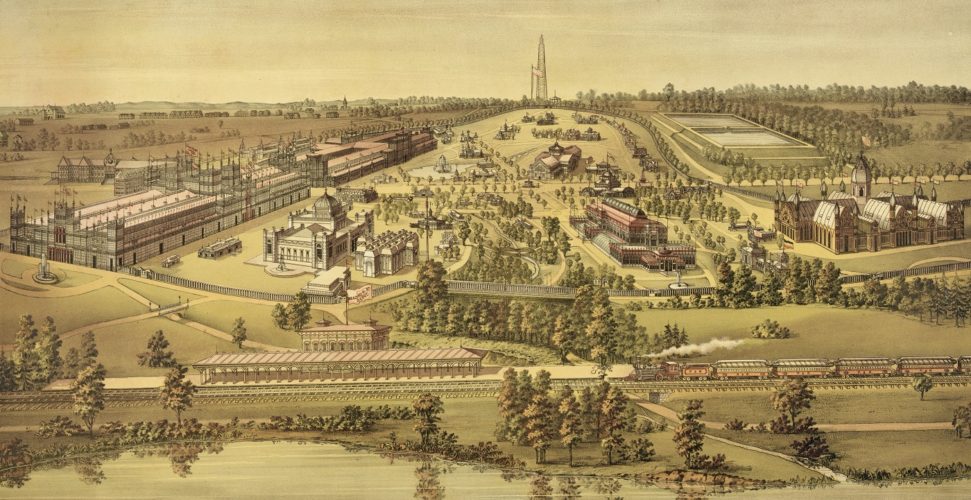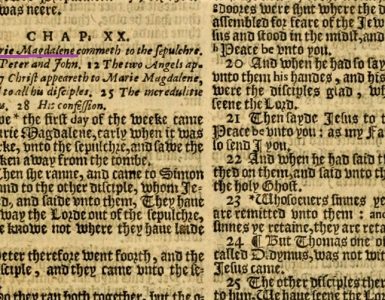The International Exhibition of Arts, Manufactures and Products of the Soil and Mine was held in 1876 to commemorate American independence one hundred years earlier. Fortunately, it has come to be known more briefly as the Centennial Exposition or Philadelphia Centennial, but for this post simply Exposition will be used. The Exposition was a massive project with 200 buildings constructed on about 286 acres of Fairmount Park along the Schuylkill River. The grand opening was planned for April to commemorate the battles of Lexington and Concord but logistics problems combined with construction delays pushed the opening to May 10 with the gates scheduled to close permanently November 10. It was a massive, expensive, no holds barred world’s fair declaring that after just a century as a nation the United States of America was officially a world player and everyone should stand up, take notice, and expect great things. The Exposition promoted all things American including machinery, metals, mining, horticulture, agriculture, art, music, national resources, science, cuisine, and the aesthetic beauty of the country. An example of the impressiveness of the Exposition was the Corliss engine that powered over 800 machines on the grounds through a complex labyrinthine network of cogs and shafts. The engine’s two forty-four-inch diameter pistons were driven through strokes of ten feet by the external-combustion energy provided by steam. Everything was intended to be the biggest and the best in the world as exemplified architecturally by the Main Exhibition Building which measured 1880 by 464 feet yielding square footage of over 850,000. The event was not only national but international because other nations provided exhibits as gifts to the country. Everything was done in a big way because the United States was proud of its accomplishments and optimistic about its future.
If and how were the Presbyterians going to have a part in the national centennial and its Exposition?
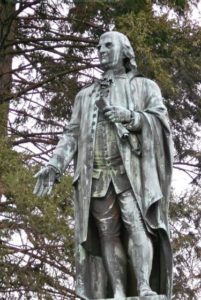 Presbyterianism had contributed to the progress of the United States via three key influences. First, the pattern for representative government of the United States followed that of presbyterian polity; secondly, many schools and colleges in the land were started by Presbyterians; and thirdly, much of the Protestant Christian influence in the mid-Atlantic and southern states was from Presbyterians. The question of the Centennial came before the General Assembly of the Presbyterian Church in the United States of America (PCUSA) in 1872. With much enthusiasm the commissioners appointed a Centennial Committee of thirteen members—likely, to honor the thirteen original colonies, who were to “take this subject into consideration, and make a report thereon to the next General Assembly.” The members included twelve from the Philadelphia area: William P. Breed, Henry A. Boardman, Stephen W. Dana, George Hale, Addison Henry, George Junkin, George Musgrave, Alfred Nevin, William A. Porter, William E. Schenck, and J. Ross Snowden, with a lone representative from Pittsburgh, Alexander W. Sproull. When the Centennial Committee recommendations were adopted the next year they included presenting a display of Presbyterian Board of Publication books and church artifacts at the Centennial; taking a collection for building a fire-proof facility for the Presbyterian Historical Society; offering a series of historical discourses on eras of Presbyterian history; dedicating the first Sabbath in July 1876 to be “a Day of Praise and Thanksgiving to God for the manifold blessings with which he has crowned us as a people”; and inviting “other branches of the Presbyterian Church in the nation to cooperate with us in this work in so far, and in such manner, as they may deem expedient.” The Centennial Committee was aided in its efforts by addition of a sub-committee charged with finding speakers for the historical discourses. When the Assembly convened in Cleveland in 1875, the Centennial Committee report had an addition tacked on its end. It was an important addition and as the years have passed it is probably the most enduring aspect of the celebration. A statue was to be cast honoring Presbyterian Scot-American John Witherspoon. Even though the Centennial Committee did not mention its reasoning for the selection of Witherspoon, he was surely the ideal person to image in bronze because he embodied all three of the influences provided by the Presbyterian Church in American history.
Presbyterianism had contributed to the progress of the United States via three key influences. First, the pattern for representative government of the United States followed that of presbyterian polity; secondly, many schools and colleges in the land were started by Presbyterians; and thirdly, much of the Protestant Christian influence in the mid-Atlantic and southern states was from Presbyterians. The question of the Centennial came before the General Assembly of the Presbyterian Church in the United States of America (PCUSA) in 1872. With much enthusiasm the commissioners appointed a Centennial Committee of thirteen members—likely, to honor the thirteen original colonies, who were to “take this subject into consideration, and make a report thereon to the next General Assembly.” The members included twelve from the Philadelphia area: William P. Breed, Henry A. Boardman, Stephen W. Dana, George Hale, Addison Henry, George Junkin, George Musgrave, Alfred Nevin, William A. Porter, William E. Schenck, and J. Ross Snowden, with a lone representative from Pittsburgh, Alexander W. Sproull. When the Centennial Committee recommendations were adopted the next year they included presenting a display of Presbyterian Board of Publication books and church artifacts at the Centennial; taking a collection for building a fire-proof facility for the Presbyterian Historical Society; offering a series of historical discourses on eras of Presbyterian history; dedicating the first Sabbath in July 1876 to be “a Day of Praise and Thanksgiving to God for the manifold blessings with which he has crowned us as a people”; and inviting “other branches of the Presbyterian Church in the nation to cooperate with us in this work in so far, and in such manner, as they may deem expedient.” The Centennial Committee was aided in its efforts by addition of a sub-committee charged with finding speakers for the historical discourses. When the Assembly convened in Cleveland in 1875, the Centennial Committee report had an addition tacked on its end. It was an important addition and as the years have passed it is probably the most enduring aspect of the celebration. A statue was to be cast honoring Presbyterian Scot-American John Witherspoon. Even though the Centennial Committee did not mention its reasoning for the selection of Witherspoon, he was surely the ideal person to image in bronze because he embodied all three of the influences provided by the Presbyterian Church in American history.
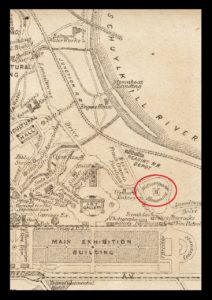 The cornerstone of the monument pedestal was set on its foundation in November 1875 during the confusion of contractors and crews working to build the expansive Exposition complex. Presbyterian Centennial Committee member Rev. George Musgrave led the celebration during an absolutely miserable, wet, and cold day. Those who could not abide the weather were encouraged to go to Machinery Hall and await conclusion of the setting process when Dr. William Adams would deliver a discourse to the attendees. Those braving the dreary weather outside could not appreciate the spectacular site the sculptor, Joseph A. Bailly, had selected. It was in a corner of the Exposition’s grounds at a height sufficient to provide a view of the Schuylkill River, its steamboat landing, and the near-by Reading Railroad Exposition Station. With the cornerstone set, things were going well in terms of the schedule.
The cornerstone of the monument pedestal was set on its foundation in November 1875 during the confusion of contractors and crews working to build the expansive Exposition complex. Presbyterian Centennial Committee member Rev. George Musgrave led the celebration during an absolutely miserable, wet, and cold day. Those who could not abide the weather were encouraged to go to Machinery Hall and await conclusion of the setting process when Dr. William Adams would deliver a discourse to the attendees. Those braving the dreary weather outside could not appreciate the spectacular site the sculptor, Joseph A. Bailly, had selected. It was in a corner of the Exposition’s grounds at a height sufficient to provide a view of the Schuylkill River, its steamboat landing, and the near-by Reading Railroad Exposition Station. With the cornerstone set, things were going well in terms of the schedule.
Bailly announced to the Centennial Committee that the model for the statue was completed in June 1875 and it had been hauled to Robert Wood & Sons foundry for the bronze statue casting process. The foundry completed the statue February 1, 1876 and it was placed on temporary display at the foundry awaiting installation upon its pedestal on the Exposition grounds. There appears to have been plenty of time to set the Witherspoon monument before its planned unveiling during the PCUSA General Assembly convening in Brooklyn at the Tabernacle Presbyterian Church, May 18. There were three and a half months to get the job done, but the deadline was not met. Frank L. Thomas, a young man of seventeen, said in his diary of a trip to Philadelphia and the Exposition that he passed the foundry on July 13 and “saw the statue of Rev. John Witherspoon one of the signers of the Declaration of Independence which is to be placed in Fairmount Park.” The placement of the statue was already about two months late. If commissioners to the Brooklyn Assembly saw the bronze, they had to visit the foundry. What happened?
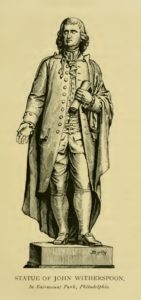 The Witherspoon statue project had been dogged by money problems from the beginning. Bailly had taken the commission for the statue without any money up front and only the promise of the Centennial Committee that “they would do all in their power to secure the money to remunerate him for his work.” Mr. Bailly was either a very trusting or desperate man. The month before Frank Thomas’s viewing of Witherspoon in bronze, the Presbyterian ladies had been asked by the Centennial Committee to raise three-thousand dollars, which was quite a tidy sum in 1876. William M. Paxton commented that the “ladies of the auxiliary set to work with characteristic energy” and “Witherspoon stands upon his pedestal owing no man anything.” Note the play on words from Romans 13:8 as Paxton pointed out that the men had not accomplished the job. Whether the statue could not be moved because Robert Wood & Sons had not been paid, or the riggers moving Witherspoon required funds up front is not clear, but regardless, the women raised the money. There were several editions of maps and guidebooks published for visitors to the Exposition and a comparison of their content shows confusion about the Witherspoon statue. In some guides and maps, the site is not marked or noted at all, while others locate the site and its access road without the statue, and still others have the statue in position. One map even has what appears to be a concession stand in the place of the bronze statue. Once the image of John Witherspoon was placed, it was time for its dedication five months late.
The Witherspoon statue project had been dogged by money problems from the beginning. Bailly had taken the commission for the statue without any money up front and only the promise of the Centennial Committee that “they would do all in their power to secure the money to remunerate him for his work.” Mr. Bailly was either a very trusting or desperate man. The month before Frank Thomas’s viewing of Witherspoon in bronze, the Presbyterian ladies had been asked by the Centennial Committee to raise three-thousand dollars, which was quite a tidy sum in 1876. William M. Paxton commented that the “ladies of the auxiliary set to work with characteristic energy” and “Witherspoon stands upon his pedestal owing no man anything.” Note the play on words from Romans 13:8 as Paxton pointed out that the men had not accomplished the job. Whether the statue could not be moved because Robert Wood & Sons had not been paid, or the riggers moving Witherspoon required funds up front is not clear, but regardless, the women raised the money. There were several editions of maps and guidebooks published for visitors to the Exposition and a comparison of their content shows confusion about the Witherspoon statue. In some guides and maps, the site is not marked or noted at all, while others locate the site and its access road without the statue, and still others have the statue in position. One map even has what appears to be a concession stand in the place of the bronze statue. Once the image of John Witherspoon was placed, it was time for its dedication five months late.
It was Friday, October 20, 1876, just a month before the Exposition gates would close when the unveiling occurred. William M. Paxton, minister of First Church, New York, as part of the unveiling ceremony read the inscriptions on each of the four sides of the statue’s base.
On the east side: “John Witherspoon, D.D., LL.D., a lineal descendant of John Knox, born in Scotland February 5, 1722; ordained minister in the Presbyterian Church, 1745; president of the College of New Jersey, 1768-1794. The only clergyman in the Continental Congress; a signer of the Declaration of Independence; died at Princeton, N. J., November 15, 1794.”
On the west side: “This statue is erected under the authority of a committee appointed by the General Assembly of the Presbyterian Church in the United States of America, July 4, 1876.”
On the south side: “Proclaim liberty throughout all the land, unto all the inhabitants thereof. Lev. 20:10.” [The inscription on the Liberty Bell.]
On the north side: “For my own part, of property I have some, of reputation more; that reputation is staked, that property is pledged, on the issue of this contest. And although these gray hairs must soon descend into the sepulcher, I would infinitely rather that they should descend thither by the hand of the executioner than desert at this crisis the sacred cause of my country.—Dr. Witherspoon.”
Just as Dr. Paxton pronounced the word country at the end of the Witherspoon quote, the Honorable D. W. Woods of Lewistown, Pennsylvania, a grandson of Dr. Witherspoon, pulled a cord, resulting in the flag which enveloped the bronze falling, suddenly exposing to view the colossal form of John Witherspoon. A thrill of surprise and admiration ran through the crowd. Paxton was for the moment forgotten as shouts and applause rent the air. When quiet was restored, Dr. Paxton proceeded as follows:
That monument may perish, but this sentiment (of Witherspoon’s) will live forever. As the reward for his signature to the Declaration of Independence he expected the executioner’s axe, but instead of this he has found the sculptor’s chisel. He staked his reputation upon the issue of that crisis and has won immortality. He staked his property, and he himself has become the property of his countrymen.
It was good that the Presbyterians embraced the opportunity to participate in the Exposition. Only two of the Exposition’s 200 buildings remain—the current Please Touch Museum, originally Memorial Hall, and the present Centennial Café, originally Ohio House. One would have expected more buildings to survive. But there is another survivor. John Witherspoon has been standing on his pedestal nearly 150 years. The bronze Scot-American with his Geneva gown draped over his arm symbolizing his ministerial calling stands more than twice-life size upon his pedestal. His panorama has changed from horses and carriages passing on a path, to horseless carriages on gravel, and then modern automobiles on asphalt. He now gazes at utility lines and a crooked wooden sign warning visitors not to park on the grass. The Schuylkill River cannot be seen from the statue’s promontory anymore because of thick trees backed by Interstate 76 (note the use of 76 in Philadelphia). Even though the statue’s scenic original site is not what it used to be, John Witherspoon continues to stand as first of all, a minister of the Gospel; secondly, a Scot-American patriot; and thirdly, a dedicated educator.
You may want to read the next post, “John Witherspoon, Lecture Life and Works,” which includes William S. Plumer’s discourse on Witherspoon delivered in October 1876.
Barry Waugh
Notes—For information about the identical statues of John Witherspoon in Scotland and Princeton and biographical information, see on this site, “John Witherspoon, 1723-1794.” There is also a statue of Witherspoon on the grounds of the Presbyterian Historical Society, 425 Lombard Street. At one time the PHS was in the Witherspoon building.
The PCUSA General Assembly minutes, 1872-1877, were an important source. Information about the buildings and property of the Exposition were obtained from “What Happened to the Buildings from the 1876 Centennial in Fairmount Park?” on The Philadelphia Inquirer website, and from Philadelphia: A 300-Year History, ed. Russell F. Weigley, New York: W. W. Norton, 1982.
The color header image is from Wikimedia Commons “Bird’s Eye View, Centennial Buildings, 1876.” The Witherspoon statue would be off the image to the left. The large building on the left is the Main Building which was described in the first paragraph of this article. In the foreground is the landing for steamboats. The train is approaching the Reading Railroad Exposition Depot.
The section of a map of the Exhibition is from a nice high-resolution one at https://digital.library.cornell.edu/.
The description of the current Witherspoon statue situation is based on using the street view of an online mapping site, May 18, 2020.
The George Junkin on the Assembly’s Centennial Committee was a son of the George Junkin having a biography on this site.
The quote is on page 3 of young Thomas’s diary which measures 3 1/2″ x 5″, has 32 pages, and covers the trip from July 12 to 26, 1876. The handwriting is quite legible. It is held by the Free Library of Philadelphia and can be viewed online. It might make a nice source for a school or home school student paper, but of course, those students encumbered with not having been taught cursive writing, sadly, would find the diary challenging.
Address for the color picture of the Witherspoon statue is—https://commons.wikimedia.org/wiki/File:Witherspoon_Hort_Center.JPG


